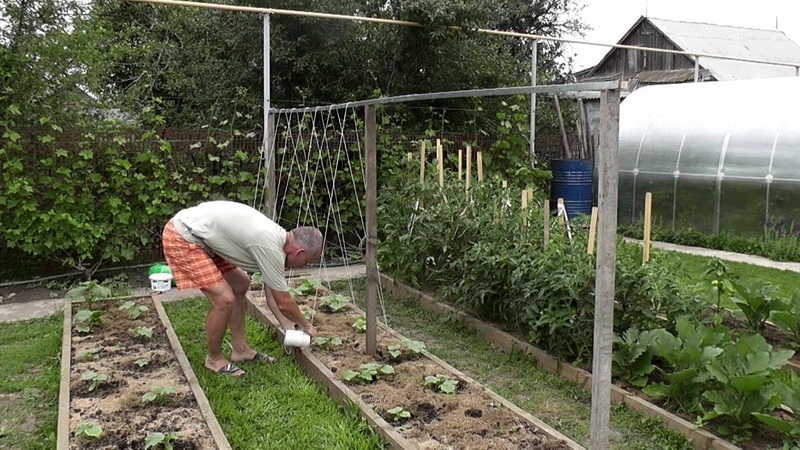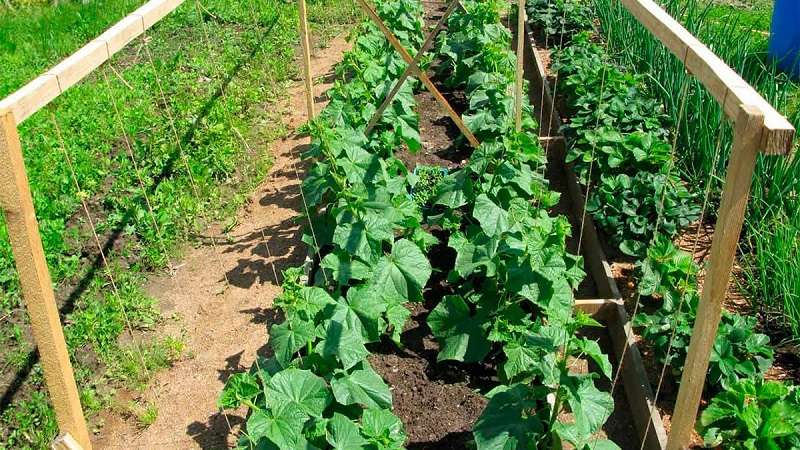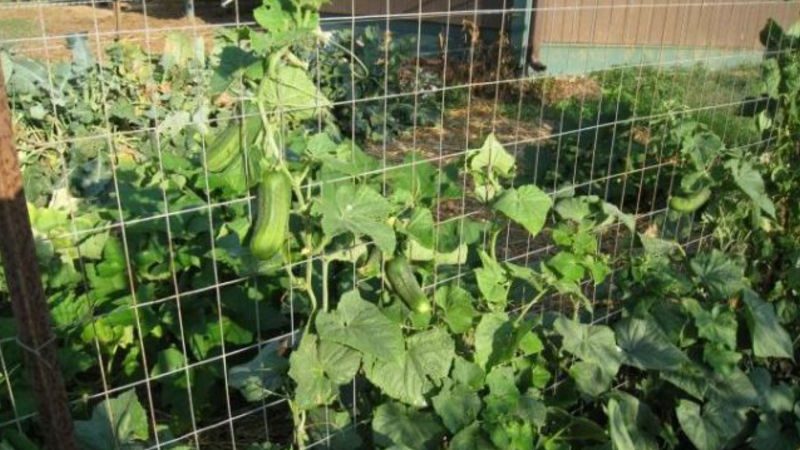Instructions for the formation of cucumbers on a trellis in the open field for novice summer residents
Cucumbers, like all climbing plants, strive for the sun. In search of support, they cling to neighboring plants and affect their growth. Therefore, growing a culture, summer residents build special trellis structures that help to care for plantings, form whips and collect fruits.
The content of the article
What is a trellis
Gardeners practice two ways of growing cucumbers - horizontal, when the plant spreads on the ground, and vertical, i.e. lianas tie up to special devices (trellises), along which the plant weaves up.

The vertical growing method has the following advantages:
- vines are illuminated from all sides, well ventilated, saturated with oxygen, less likely to get sick;
- easier to harvest and care for the plant;
- it is easier for insects to pollinate cucumber flowers;
- ripening of the crop takes place 2 weeks faster than when using the horizontal method;
- beds with green lashes on a trellis will decorate any vegetable garden and take up less space than with another growing method;
- the fruits are clearly visible on the whip, they are clean and do not rot, since they do not come into contact with damp ground, where there are many pathogens;
- when pests or signs of disease appear easily process the plant from all sides with the necessary preparations.
The only drawback is the need to build the structure itself. However, now you can buy convenient devices that are easy to assemble and disassemble. They are removed from the garden for the winter until the next planting season.
Step-by-step instructions for growing cucumbers on trellises
Gardeners often use walls, fences, pillars as a support, pulling wire on them. Let's take a look at how to build an independent support structure.
How to make a trellis
For the construction of a structure, wooden or metal pillars (30 mm) are dug in on opposite edges of the beds at a distance of 1.5-2 m from each other. The height of the posts from the surface of the earth is 2-2.2 m. A metal wire is pulled between them in 2-3 rows:
- the first row - at a height of 15 cm from the surface of the earth;
- the second - 1-1.2 m;
- third - 2 m.
One end of a strong twine is tied to the top row, and the other to a cucumber whip at a distance of 10 cm from the ground. Instead of twine, a mesh made of plastic or metal wire with a mesh of 10-15 cm is becoming popular.
To prevent the mesh from sagging under the weight of ripening cucumbers, it is fixed on a horizontal bridge, forming a U-shaped structure with a mesh inside.
A hut-like structure is considered more stable.
Initial stage and preparation for landing
An important condition for obtaining a good harvest is the location of the trellis on the site. The structure is placed following the instructions:
- The support is installed on the sunny side of the site without drafts. You can protect the plant from the wind by planting corn or sunflower.
- The ground should be level or slightly sloped.
- The soil is prepared in advance for planting plants, fertilized with organic dressing.
- The best area for cucumbers is considered to be where potatoes, peas, cabbage or tomatoes grew.
In the spring, the soil under the cucumber garden is treated with boiling water.This will eliminate bacteria that did not die in winter and activate the heat production of manure and compost.
Planting cucumbers
Cucumbers are planted in a garden bed with seeds or seedlings next to the trellis. The distance between plants should be for normal varieties from 15 cm, for bush - from 25 cm.
Before sowing in the ground, the seeds are warmed up for 3-4 hours at a temperature of + 50 ... + 60 ° C. Then it is kept in a weak solution of potassium permanganate (1 g per 100 ml of water) or garlic pulp for 20-30 minutes.
When the ground warms up to + 15 ° C, the seeds are placed in the ground (4 seeds per 1 m) and covered with foil until the first 5-6 leaves appear. Then the film is removed.
With the seedling method of growing, young plants are transplanted into a garden bed when they reach 15-20 cm and they form from 3 true leaves. Disembarkation is carried out in late spring to reduce the risk of night frosts.
Care
To get a good harvest, you will have to monitor the fertility of the soil and regularly apply top dressing, establish systematic and correct watering, loosen the beds and form bushes. If you follow agricultural techniques, the yield may even exceed the indicators declared by the manufacturer.
Cucumbers are moisture-loving plants, so the seedlings are watered every 4-5 days. For 1 m² of land, 3-6 liters of water should go.
Important! Watering is necessary only with warm water. Cold provokes the development of fungal diseases, and the supply of water from a hose with a single stream exposes the roots.
During ripening and harvesting, enhanced feeding is required. To do this, use:
- potassium nitrate solution - 30 g per 10 liters of water;
- infusion of herbs diluted with water 1: 5;
- ash extract - 1 tbsp. on a bucket of water;
- spraying the leaves with a urea solution - 10 g per bucket of water.
Formation of cucumbers on a trellis in the open field
The choice of a method for forming a cucumber primarily depends on which group it belongs to: traditional varieties that yield evenly from the whole plant, or modern, low-growing ones, forming a crop on the main stem.

Features of the formation of varietal cucumbers, hybrids and bouquet varieties
In varietal cucumbers, predominantly male flowers appear on the main stem. Pinching the top of the plant over the fifth leaf stimulates the formation of lateral shoots. A larger number of female inflorescences are formed on them, from which the ovaries are formed.
Modern hybrids take a slightly different approach. A sufficient number of female flowers are formed on them. Towhen 3-5 true leaves appear on the stem, all shoots and buds are removed from their sinuses, which can slow down the development of the plant. This technique is called blinding. In this case, all forces will be directed to the growth of the main stem. When the stem reaches the upper horizontal, it is thrown to the other side of the trellis. When the stem on the other side grows another 60-70 cm from the top of the trellis, the top of the hanging plant pinch.
Parthenocarpic hybrids, in which flowers are formed in whole bunches, require more careful maintenance than their less productive counterparts. Bunch cucumbers are characterized by simultaneous and abundant bud formation on the main and lateral shoots. Therefore, due to the simultaneously developing fruits, the bush can greatly weaken, and some of the fruits eventually deform or disappear from lack of nutrition.
To avoid troubles, a special technology is used to form bouquet cucumbers. At 3-4 nodes of the lower tier, the rudiments of lateral lashes and ovaries are pinched off. In the remaining nodes, the rudiments of lateral shoots are blinded, but the ovaries are not touched. After fruiting ends on the main shoot, the plant is well fed so that new side lashes begin to form. Soon, secondary shoots will begin to overgrow with fresh ovaries, which are usually no less than during the first wave of the harvest.
Attention! Feed the plant in the morning or evening to avoid chemical burns.Better to fertilize after watering.
How to shape cucumbers
You can form a plant:
- in 1 stem: remove all lateral shoots simultaneously with damaged leaves and inflorescences;
- in 2 stems: remove stepsons in the first three nodes, leave over the fourth;
- in 3 stems: stepchildren are removed at the first two nodes.
Trimming lashes
Trimming of the lashes begins 3-5 weeks after planting in the ground and the beginning of growth. By this time, the height of the plant should reach at least 0.5 m. Pruning is carried out every 2 weeks. This helps the plant retain nutrients for greater fruiting.
Important! If you start pruning at a plant height of up to 0.5 m, it will not have time to develop, and you can be left without a crop at all.
What is the difference between shaping on a trellis in a greenhouse
Growing cucumbers in a greenhouse and open field are different things, so you should thoroughly approach the choice of seeds for planting. Among the most popular varieties of cucumbers, you can find varieties that do not require shaping or are single-stemmed.
In the greenhouse, the lower part of the stems should not be allowed to thicken, otherwise excess moisture will appear, which contributes to the development diseases... Every 10-14 days, the 2 bottom leaves are cut off, as they take up a lot of juices. Do not cut more than 2 leaves, so as not to weaken the lash.
In greenhouse cultivation, the stem is always directed upward, regardless of how many lashes the plant is formed.
The top that has reached the greenhouse ceiling must be pinched off. Or you can do otherwise - roll the bare stem from below (previously fruits, shoots, leaves were removed from it) to roll up a loop. To do this, it is lowered down the twine and the resulting loop is tied to a lash on the twine. The top will drop, and it will have room for further growth.
Tips and secrets of experienced summer residents

Experienced gardeners always have useful tips for beginners that have been proven over the years:
- It is necessary to engage in plant formation in the morning. For a day, pinching wounds will have time to heal.
- Leaves and vines cannot be turned in the opposite direction. A violently deployed shoot can stop growth, turn yellow, or even die.
- Cutting the lashes is performed only with clean tools. This will avoid contamination of the plant.
- You should not plant cucumbers for several years in a row in one place. Pests and pathogens accumulate in the soil.
Conclusion
Recently, many gardeners have made a choice in favor of growing cucumbers on trellises. When using the support, there is no need to bend over again when harvesting. When spraying plants on structures, the solution evenly falls on the stems and leaves. In addition, space is significantly saved. All this speaks in favor of the use of tapestries.